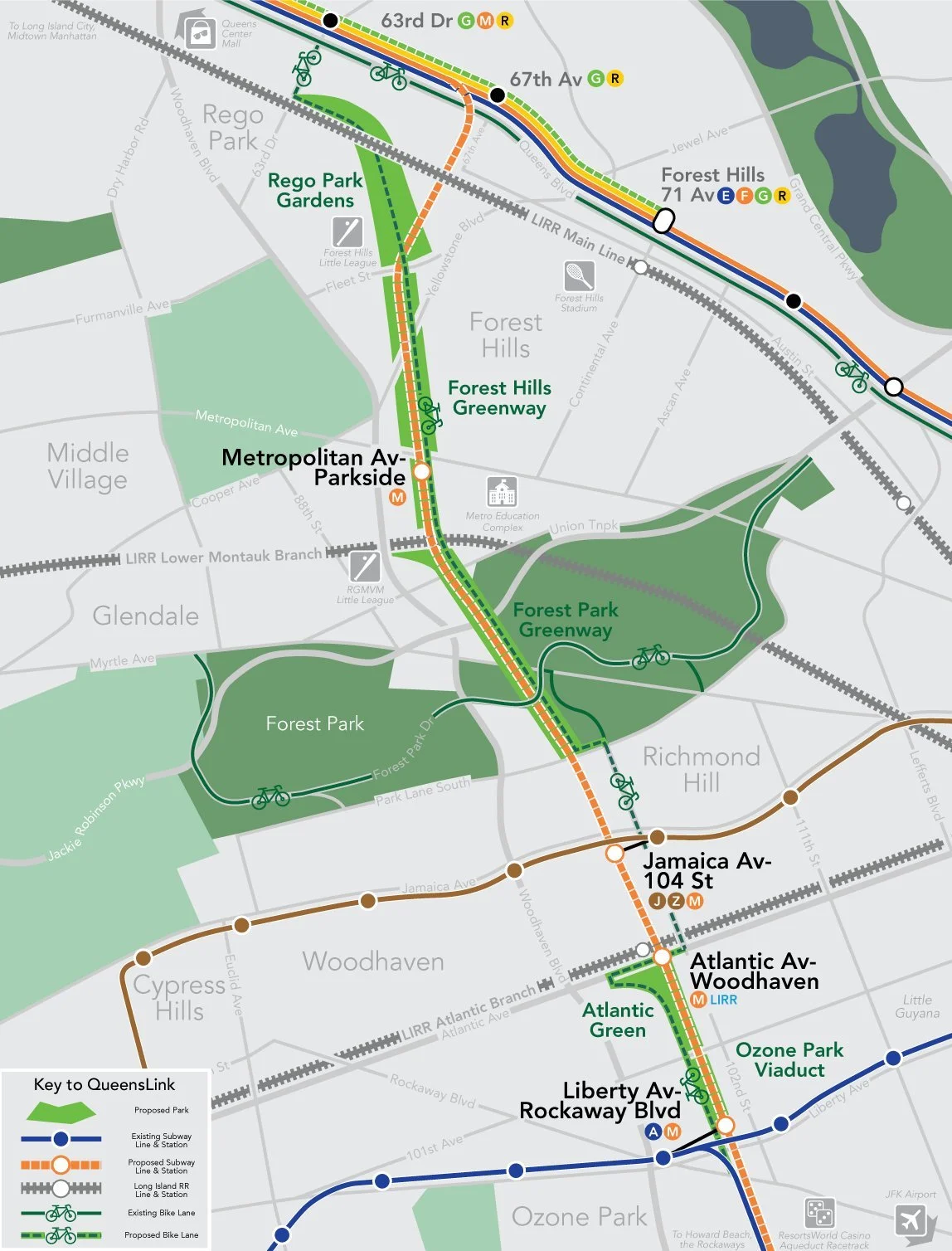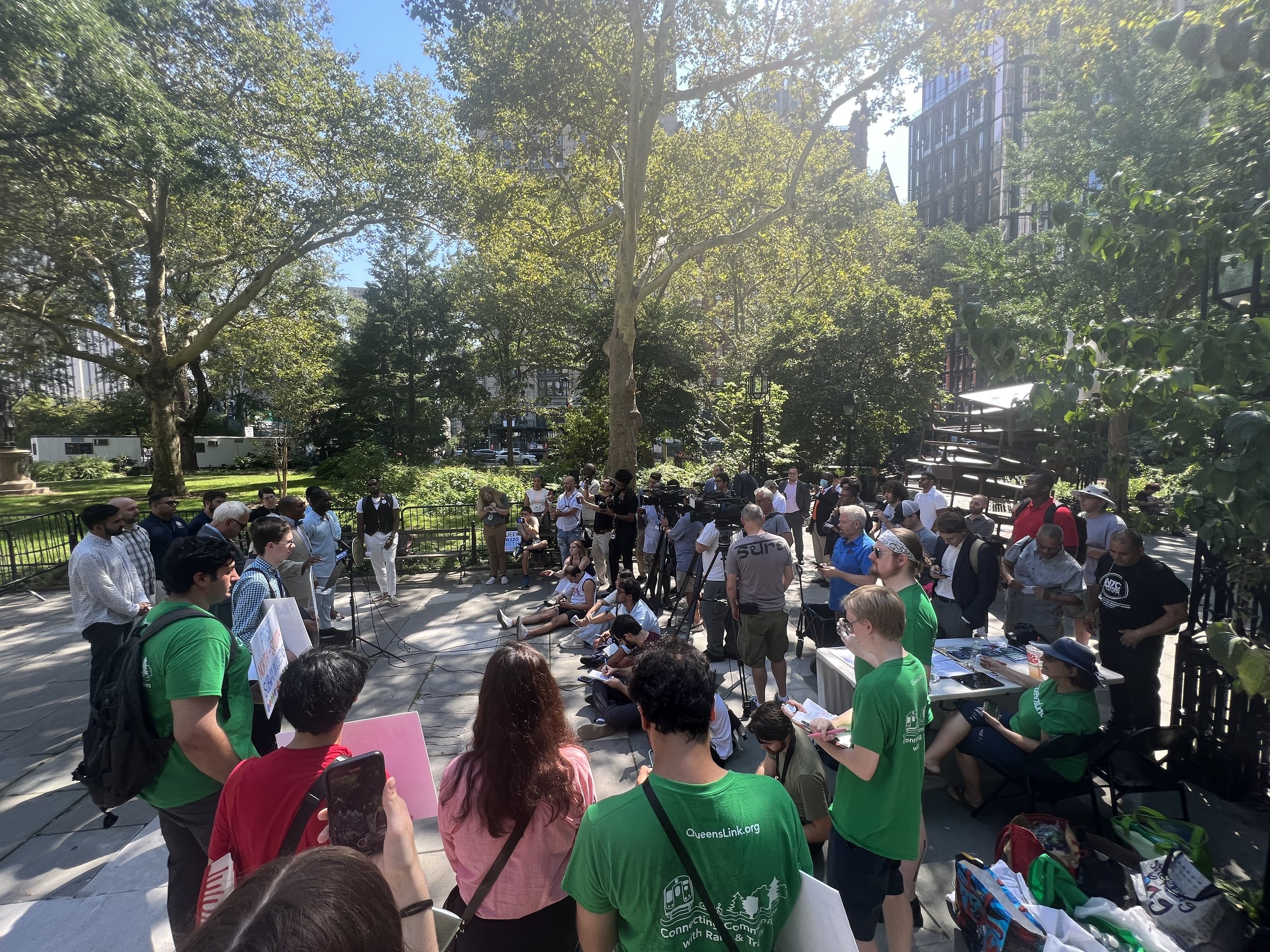Queens rallies for QueensLink at City Hall
/QueensLink hopes to use pre-existing tracks to improve commutes for Queens residents. Rendering via QueensLink
By Ryan Schwach
Nearly a year after the mayor announced that his administration was choosing to build a park over a 3.5 mile strip of abandoned rail that cuts through Central and South Queens, a group of supporters hoping to revive the rail line rallied at City Hall on Wednesday.
Central to the rally in support of the project, known as the QueensLink, was a call to Mayor Eric Adams and the governor to kickstart an environmental impact study on the project, which supporters say will provide a crucial missing transportation link for thousands of Queens residents.
Supporters of the QueensLink project brought their fight to Manhattan on Wednesday, hoping to bring more attention to the plan and garner more support outside of the South and Central Queens neighborhoods that have known about the project for years.
“This is a rally to get into the mayor and governor's ear that this is an important project for the borough and the city and the state,” said Rick Horan, the executive director of the QueensLink Project. “It's an economic generator, as well as the responsible thing to do environmentally.”
Rallying in support of the project on Wednesday were Queens Borough President Donovan Richards, Councilmembers Selvena Brooks-Powers, Robert Holden, Nantasha Williams and Joann Ariola, Assemblymembers Khaleel Anderson, Zohran Mamdani and Stacey Pheffer Amato and State Senator James Sanders.
For Rockaway representatives like Ariola and Pheffer Amato, the QueenLink, which would potentially run from Rego Park to the Rockaways, has garnered their support since they first took office. They now hope to expand the support to their other citywide electeds.
“As a lifelong resident of South Queens, I am well acquainted with the transportation issues facing our area,” said Ariola. “QueensLink represents an opportunity to address these issues head-on by revitalizing a long-dormant train line, transforming it into something that can truly benefit tens of thousands of New Yorkers every day.”
“That's why I'm pushing so hard to get this EIS completed, so we can finally turn this project into a reality and provide the people of South Queens with the transportation options they deserve,” she added.
Brooks-Powers, also the chair of the council’s transportation committee, has long supported the project.
“For generations, outer borough communities of color have not received a proportionate share of the City’s investment,” she said in a statement. “Too many communities – like the one I represent – remain transit deserts, underserved by the City’s core public transit network. QueensLink could help address this legacy of underinvestment by placing more Queens residents within reach of the City’s subway system.”
“That is why I am proud to sponsor a resolution calling on the MTA to conduct a comprehensive Environmental Impact Study on the viability of this project,” she added.
Currently, Rockaway commuters face the longest commute to midtown of nearly any other neighborhood in the five boroughs. Although there are several public transit options to take commuters from the neighborhood to Manhattan, they each take more than an hour.
QueensLink supporters claim that the reactivated railway could shorten that by around 25 minutes.
"Public transportation is crucial in the day-to-day lives of Queens residents, especially my constituents who face the longest commute times in the entire city,” said Pheffer Amato. “Expanded public transportation access is long overdue for the commuters of Queens, and QueensLink needs our support. It’s time for our voices to be heard, and for an EIS to finally get funded."
The QueensLink would activate an old section of elevated subway tracks and connect existing routes. The project, as proposed by Horan and his group, would also included the construction of four new Queens stations, and include new parks beneath the elevated tracks.
For Horan, the project is a no-brainer.
“You've got a transit desert, and then you have an unused right of way right in the middle of the most congested roads in the borough, Woodhaven Boulevard and Van Wyck,” said Horan.
A number of elected officials rallied in support of the QueensLink proposal in front of City Hall on Wednesday. Photo via Rick Horan
Wednesdays rally comes around a year after Adams announced a $35 million allocation for the Queens Way project, High Line-like park on the same right of way that QueensLink hopes to use. Although the city said the allocation does not preclude the potential for the QueensLink to be built, advocates have not been convinced that Adams has killed their transit project.
“Mayor Adams last fall announced a $35 million in new open space for Queens residents, and the administration is moving that work forward with community engagement underway and a design consultant on board,” a mayor’s office spokesperson said. “As we’ve always said, the proposed Met Hub does not preclude an MTA project if they determine one is feasible, and we are ready to partner with them if they decide to move forward.”
Regardless, transportation advocates still hope to change the mayor’s mind and get him more behind the project.
“You could have an opinion, maybe you have no need for transit, no use for it, and you'd prefer that a transit right away be converted to a park. That might be your position, but I can't imagine that that's the majority opinion,” said Horan. “We're confident that with additional information, the mayor will make the right decision.”
QueensLink backers hope the project could be included in the MTA’s 20-year needs assessment for 2025 to 2044. Currently, the project is listed under “potential expansion and enhancement projects to be evaluated” on the MTA’s website.
“Reactivation of the LIRR's Rockaway Beach Branch is one of more than 20 concepts being analyzed by the MTA as part of its comparative evaluation of potential expansion projects being undertaken as part of the Authority's 20 Year Needs Assessment,” an MTA spokesperson said Wednesday.
The assessment will be presented next month, the spokesperson added.
“We suspect that judging fairly, QueensLink will do quite well in the nine criteria that they have been established for determining the relative value of these projects they're looking at,” said Horan.
Another reason pols want to see QueensLink come to fruition; the lack of current transit options available to Queens residents.
“Southeast Queens has existed in a transit desert for far too long,” said Richards. “The QueensLink proposal would give Southeast Queens residents a new transportation option that would make getting around much easier. The time is now to get the train moving on the Environmental Impact Statement that is needed to turn the vast promise of QueensLink into a reality.”
Along with the coalition of Queens electeds, many of whom have supported QueenLink for years, supporters hoped to grow that coalition at Wednesday's rally.
“The rally hopefully, will help give this project and this subject in general, greater visibility,” said Horan.
Horan said that though the project aims to help Queens residents, it should be a project that gets more attention across the five boroughs.
“We have right of ways that go through several council districts, it needs to be a larger conversation that includes all the council districts that are affected, if not the entire city,” he said. “So, we're trying to get some more of the councilmembers involved that are key to certain committees.”
“Let's have a thorough discussion, thorough study, put our heads together and see if this makes sense,” he added.





